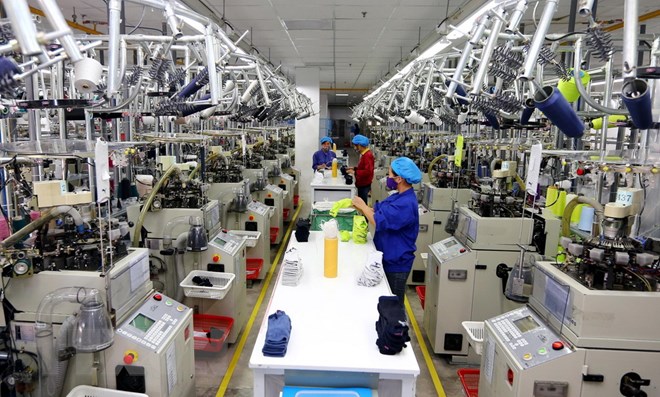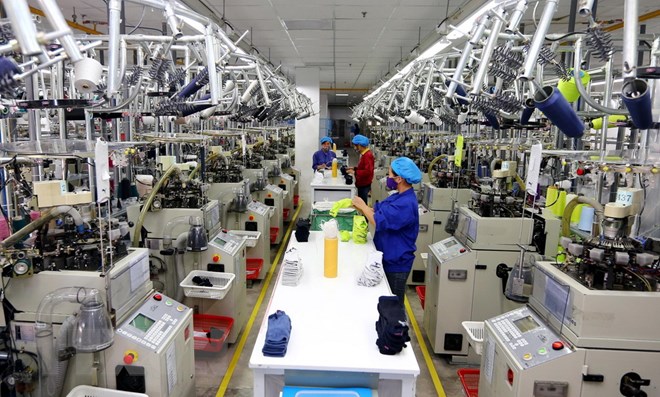
The year 2018 ends with several records, which are the highlights in the national economic panorama, laying the firm foundation for the country to strive to successfully implement the Resolution of the 12th National Party Congress and Resolution 142/2016/QH13 on the five-year socio-economic development plan for 2016-2020.
A production line in the Jasan Textile and
Dyeing Vietnam in VSIP Hai Phong, which is invested by China (Photo: VNA)
The
nation’s GDP grew by an 11-year record 7.08 percent, double the inflation rate,
while trade surplus topped 7.2 billion USD, the highest ever figure.
Disbursement of foreign direct investment (FDI) also reached a record 19.1
percent. Inflation was kept under 4 percent for the third consecutive
year.
*Growth in most fields
"We
have been able to achieve growth in most fields in the context of complicated
international situation, particularly maintaining macro-economic stability and
a high growth rate, thus winning the confidence for nearly 100 million people,”
Prime Minister Nguyen Xuan Phuc said about the efforts of the entire political
system, localities, the business community and people nationwide.
The world economic situation saw many unfavourable developments in 2018,
including the rising trend of trade protection, the US-China trade war, rising
interest rates, and complex fluctuation of oil prices.
In the country, many outstanding problems remained unsolved, such as limited
productivity, slow disbursement of investment capital despite improvements, and
lower-than-expected economic restructuring, which hindered the growth
pace.
In such circumstances, the good economic indicators demonstrated the success of
the Government’s governance and the great efforts of the business community and
the people.
The highlights in the Government’s management in 2018 were the Resolutions
19/NQ-CP and 35/NQ-CP on improving the business environment and facilitating
enterprises’ development, along with Resolution 139/NQ-CP on a plan of actions
to cut costs for enterprises.
The effects of the Government’s actions can be seen in the number of new
businesses established during the year – 131,275 new enterprises, up nearly
5,000 from 2017.
Improvements in Vietnam’s business and investment environment during the year
were recognised by the international community. The World Economic Forum, in
its Global Competitiveness Report 2018, ranked Vietnam 77th among 140 economies.
The European Chamber of Commerce in Vietnam (EuroCham) also noted significant
enhancement of the business climate in the country. The UK-based financial and
business information firm FTSE Russell has added Vietnam’s equity market onto
its reclassification watchlist, a sign that could help raise the status of the
Vietnamese market in the global markets
Vietnam also made great efforts to perfect institutions, mechanisms and
policies towards meeting international practices.
According to Finance Minister Dinh Tien Dung, the country has carried out its
commitments on import-export tariffs and opening of the financial service
market in line with international agreements to which it is a member.
Such moves have helped Vietnam attract FDI and boost foreign trade. As of the
end of 2018, the country has 27,353 valid FDI projects from 130 countries and
territories with a total 340 billion USD in register capital. The FDI sector
accounts for a quarter of total social investment and more than 70 percent of
export value, creating 8.5 million jobs. Meanwhile, foreign trade revenue in
2018 totalled 482.2 billion USD, also a record figure.
The economic restructuring has resulted in less dependence on the exploitation
of minerals and natural resources as well as credit.
According to the Finance Ministry, the contribution of crude oil to the State
budget has decreased continuously, from an average 30 percent during 2006-2020
to 4 percent this year, and is estimated at 3.2 percent in 2019.
Meanwhile, credit growth was at 13 percent this year to December 14, lower than
the level in 2017.
* Seeking new driver for growth
Think
tanks and experts said Vietnam faces several risks and challenges in 2019. They
pointed to the pressure created by the USD exchange rate and the world prices,
the tension from the prolong trade friction among big economies, rising trade
protectionism.
The enforcement of international trade deals to which Vietnam is a member
brings not only opportunities but also big competition for domestic production
and business.
As 2019 is the key year for the success of the 2016-2020 socio-economic
development plan, experts said the country needs to seek more driving forces
for economic growth, first of all in the new stage of international integration.
Next year Vietnam will complete the roadmap for its commitments as a member of
the World Trade Organisation and the ASEAN Trade in Goods Agreement, and will
begin to perform its promises under several major free trade deals including
the Comprehensive and Progressive Agreement for Trans-Pacific Partnership
(CPTPP) and the Vietnam-European Union Free Trade Agreement with deep and
comprehensive commitments.
Those FTAs are hoped to create a driving force for the Vietnamese economy
through the high openness of the economy and more opportunities for FDI
attraction.
The strong development of the private economic sector will also help drive the
domestic economy forward. In addition, the restructuring inside each economic
sector is expected to boost economic growth both in speed and quality,
according to Director General of the General Statistics Office Nguyen Bich Lam.
He cited as example the shift from low-value crops and animals to those of
higher value in the agricultural sector, or the shift to industries making
products with high added value and export value.
* Optimize every opportunity
At a year-end working session, the Prime Minister’s advisory team noted that
the economy has great potential while many new opportunities are expected to
come next year. They said the growth pace can be maintained in the next two
years if the country can take effective measures to optimize opportunities and
better tap the economy’s potential.
The team presented three scenarios for the economy during 2018-2020, under
which the economy would grow at an average 6.86 percent a year (scenario 1),
6.91 percent (scenario 2) and 7.06 percent (scenario 3). The team also
recommended striving for a growth rate of 6.9 – 7 percent and an inflation rate
of under 4 percent in 2019.
In order to realise these targets, the advisory team said the
manufacturing-processing industry and services must be made the main drivers of
the economy and must achieve a higher growth than in 2018. Stronger measures
are also needed to promote the private sector.
The team proposed that the Government focused its leadership on removing the
four key bottlenecks, which are those in implementing large-scale projects,
developing the private economic sector, firms’ investment in agriculture and
better tapping social resources.
They urged the Government to put strong pressure on ministries, agencies and
local administrations in the implementation of instruction of the Government
and the Prime Minister.
Source: VNA
According to data from the Hoa Binh Provincial Party Committee, the industrial production index for the first six months of 2025 is estimated to have increased by 20% compared to the same period last year. This marks the highest year-on-year growth rate for this period since 2020.
In the first six months of 2025, Hoa Binh province’s export turnover was estimated at 1.145 billion USD, marking an 18.11% increase compared to the same period in 2024. Import turnover was estimated at $ 804 million, a 17.15% increase, which helped the province maintain a positive trade balance.
The lives of the ethnic minority farmers in Tan Lac district have gradually improved thanks to the new directions in agricultural production. This is a testament to the collective strength fostered through the professional associations and groups implemented by various levels of the district’s Farmers’ Union.
With the motto the "product quality comes first,” after nearly one year of establishment and operation, Muong village’s Clean Food Agricultural and Commercial Cooperative, located in Cau Hamlet, Hung Son Commune (Kim Boi district), has launched reputable, high-quality agricultural products to the market that are well-received by consumers. The products such as Muong village’s pork sausage, salt-cured chicken, and salt-cured pork hocks have gradually carved out a place in the market and they are on the path to obtaining the OCOP certification.
In the past, the phrase "bumper harvest, rock-bottom prices" was a familiar refrain for Vietnamese farmers engaged in fragmented, small-scale agriculture. But today, a new spirit is emerging across rural areas of Hoa Binh province - one of collaboration, organisation, and collective economic models that provide a stable foundation for production.
Maintaining growing area codes and packing facility codes in accordance with regulations is a mandatory requirement for agricultural products to be eligible for export. Recently, the Department of Agriculture and Environment of Hoa Binh province has intensified technical supervision of designated farming areas and packing facilities to safeguard the "green passport" that enables its products to access international markets.



